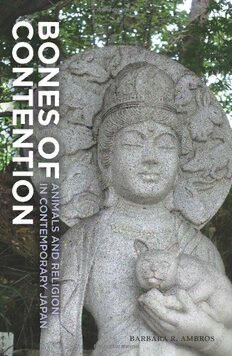
Bones of Contention: Animals and Religion in Contemporary Japan PDF
Preview Bones of Contention: Animals and Religion in Contemporary Japan
CB OO NN TE ES N O T F I O I A N N C I NO M A N L T S E M A P N O D R R A E R L Y I G J I A O P N A N barbara r. ambros bones of contention b o n e s o f c o n t e n t i o n b o n e s o f c o n t e n t i o n Animals and Religion in Contemporary Japan Barbara R. Ambros University of Hawai‘i Press | Honolulu © 2012 University of Hawai‘i Press All rights reserved Printed in the United States of America 17 16 15 14 13 12 6 5 4 3 2 1 Library of Congress Cataloging-in-Publication Data Ambros, Barbara. Bones of contention : animals and religion in contemporary Japan / Barbara R. Ambros. p. cm. Includes bibliographical references and index. 978-0-8248-3626-9 (hardcover : alk. paper) 978-0-8248-3674-0 (pbk. : alk. paper) 1. Pets — Death — Religious aspects — Buddhism. 2. Pets — Funeral customs and rites — Japan. 3. Buddhist memorial rites and ceremonies — Japan. 4. Human-animal relationships — Japan. I. Title BQ5030.D4 2012 2012019669 University of Hawai‘i Press books are printed on acid-free paper and meet the guidelines for permanence and durability of the Council on Library Resources. Designed by April Leidig Printed by Sheridan Books, Inc. Contents List of Illustrations vii Acknowledgments ix Introduction 1 one Order, Karma, and Kinship: Animals in Japanese History and Culture 17 two Masking Commodification and Sacralizing Consumption: The Emergence of Animal Memorial Rites 51 t hree Pets, Death, and Taxes: The Legal Boundaries of Religion 90 four Embodying Hybridity: The Necrogeography of Pet Memorial Spaces 124 five Vengeful Spirits or Loving Spiritual Companions? Changing Views of Pet Spirits 156 Epilogue 187 Notes 195 Glossary 223 Bibliography 231 Index 257 Illustrations 1. Segaki service at Kōsaiji 2 2. Whale memorial rite at Ryūshōin 61 3. Setting afloat offerings at Ryūshōin 62 4. Military horse memorial at Yasukuni Shrine 69 5. Memorial to blowfish at the Shinobazu Benten Hall 78 6. Memorial to sushi at the Namiyoke Inari Shrine 78 7. Map of Jimyōin’s temple precinct 97 8. Pet columbarium at Jimyōin 97 9. Individual pet graves at Jimyōin 98 10. Collective pet ossuary at Jimyōin 98 11. Map of Ekōin’s temple precinct 106 12. Ekōin’s Batō Kannon Hall 106 13. Diagram of a Japanese Buddhist altar 133 14. Pet memorial tablet 134 15. Map of Hōtokuji 144 16. Map of Izumi Memorial Park 148 17. Family grave in the cemetery of Chōfukuji 150 18. Daihiden at Jikei’in 152 19. Segaki service at Jikei’in 157 20. Pet grave at Sekai Dōbutsu Tomo no Kai 176 21. Main altar at Pet World Rikugien 176 22. Rainbow Bridge Memorial Stone at Sōhakuji 179 23. Ueno Eisaburō’s grave at Aoyama Cemetery 188 24. Statue of “Loyal Hachikō” at Shibuya Station 189 25. Urn with Hachikō’s remains at Sekai Dōbutsu Tomo no Kai 192 Acknowledgments I would like to acknowledge my colleagues, students, friends, and family who have assisted me in the completion of this book. First and foremost, I need to thank all my informants who shared their experiences with me. Without their stories and gracious cooperation this book would not have been possible. I would also like to express my gratitude to my colleagues at the Uni- versity of North Carolina at Chapel Hill and at Duke University. Tom Tweed, Laurie Maffly-Kipp, Randall Styers, Jonathan Boyarin, and Rich- ard Jaffe provided valuable feedback in the early stages of the project. Other colleagues with whom I have had the opportunity to discuss the project include Alice Kuzniar, Elizabeth Kenney, Fabienne Duteil-Ogata, Chris Ives, Stephen Covell, Ben Dorman, John Knight, Suzuki Masataka, Shimazono Susumu, and Tamamuro Fumio. Special thanks are due to col- leagues who provided additional food for thought and resources: Andrew Bernstein (who also suggested the clever title “Bones of Contention”— a vast improvement from my clunky “Contested Bones”), Hank Glassman, John Nelson, Mark Mullins, Dani Botsman, Paul Hansen, Ian Miller, and Rob Gierka. I am indebted to Helen Hardacre, Ryan Overbey, Chris Nelson, Simon Partner, Morgan Pitelka, and Duncan Williams for creating opportunities for me to present sections of this project at various stages — at the Harvard Buddhist Studies Forum, the Triangle Japan Forum, and the Tracing Japa- nese Buddhism Symposium at University of California, Berkeley. I would also like to extend my thanks to Jan Bardsley for her enthusiastic support and for allowing me to organize the Triangle East Asia Colloquium on the topic of “Animals in East Asian History and Culture.” This gave me the chance to discuss this topic with the conference participants who were mutually interested in human-animal relationships. I am thankful to all my students who took various incarnations of “Animals in Japanese Myth, Folklore, and Religions” for providing a forum that allowed me to think
